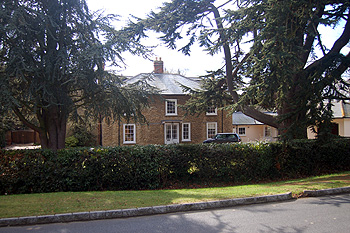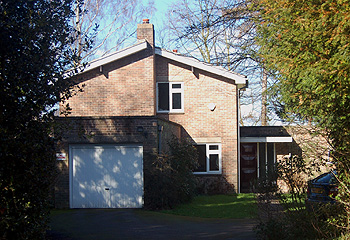Biddenham Vicarages
![The Old Vicarage in 1962 [Z53/15/16]](/CommunityHistories/Biddenham/BiddenhamImages/The Old Vicarage in 1962 [Z53-15-16].jpg)
The Old Vicarage in 1962 [Z53/15/16]
The first surviving mention of a parsonage in Biddenham is in 1541 when it was let by John Dyve of Bromham to Henry Albony of Bedford, baker, for £32/5/-. It was described as a “mansion howse”. Included in the lease were the tithes and the tithe barn [TW247]. In fact what was being leased was the rectory, meaning the position of rector rather than a place the rector lived.
Today a rector is synonymous with a clergyman but in the Middle Ages and immediately after the rector could be a layman or an institution such as a monastery. The rector would receive all the great tithes. Broadly speaking tithes were one tenth of the fruits of the labour of parishioners. Great tithes were, generally speaking, corn, peas, beans, hay and wood. Of course a layman or an institution could not minister to the parish so they employed a clergyman to act vicariously for them – the vicar. He received the small tithes, usually those relating to work other than farming.
In this case it is not clear whether the parsonage/mansion howse was a rectory, a house in which the rector, in this case Albony, a layman lived, or a house in which the vicar lived. If the parsonage was the house of the lay rector there may have been no house for a minister in the village meaning either that he would have had to rent the mansion howse from the rector, rent another house in the village or live elsewhere.
Albony was still leasing the rectory in 1553 but gave the lease to William Boteler, Lord of the Manor of Biddenham or Newnham in that year for £93/6/8 [TW248-249]. William Boteler still held the rectory at his death in 1602 and it is listed in the inquisition into his property after his death [TW610]. The rectory was held as part of the Manor of Biddenham or Newnham throughout the 17th and 18th centuries.
Volume 81 published by the Bedfordshire Historical Records Society (2002) is devoted to returns made during episcopal visitations |to the county by the Bishop of Lincoln in the early 18th century, edited by former County Archivist Patricia Bell. In 1706 the curate, John Towersey reported that Elizabeth Boteler held “both the Rectory and Vicarege [sic], and is obliged to allow a stipend of £8 per Annum to a Curate, which is all his certain Maintenance". In 1717, however, the new curate stated "I have noe house in my parish. I live in a house a little distance from my parish where I have lived 7 or 8 years”. In 1720: Teape he wrote: My residence is att Stagsden alias Stachden”.
This means that it is still an open question as to whether there was a house for the vicar in Biddenham at this time. Towersey may have meant, in his remark that Elizabeth Boteler held the rectory and the advowson – using the word vicarage for the right to institute a vicar. The comments in 1717 and 1720 certainly seem to indicate the lack of a vicarage house. Bedfordshire and Luton Archives and Records Service has a number of terriers of church property, which include vicarages, in the archive of the Archdeaconry of Bedford [ABE] but sadly nothing for Biddenham has survived.
The Old Vicarage, 67 Main Road, Biddenham was listed by English Heritage in June 1984 as Grade II, or special interest. The property probably has “18th century origins”. It is built of limestone rubble and has a hipped, slated roof. The building comprises two storeys. To the left is a two storeyed late 19th century block in limestone, again with a slate roof. With an 18th century date this building perhaps addressed the lack of a vicarage house in the village.
The Northampton Mercury of 3rd February 1772 has the following notice: “To be Lett, and Enter’d upon at lady-Day next, the VICARAGE-HOUSE at Biddenham, within a computed Mile of Bedford; consisting of two Parlors, a Kitchen, Pantry, Cellars; four Chambers and three Garrets, with convenient Closets; An Orchard, planted with choice Fruit; a Kitchen-Garden, surrounded with an handsome live Fence; a Flower Garden; a good Out-Brewhouse, a Barn, Stable, Coal-Hole, &c. all in good Repair; and if any Thing be wanting, or amiss, shall be made good to a Tenant who shell be approved of by the Rev. Tho. Richards of Bromham, Bedfordshire; of whom Particulars may be had relative to the above House”. Thomas Richards was the Vicar of Biddenham as well as the Vicar of Bromham. Clearly he lived in the latter village.

The Old Vicarage March 2012
The Rating and Valuation Act 1925 specified that every building and piece of land in the country was to be assessed to determine its rateable value. At this date the property was still the vicarage. The valuer found [DV1C123/80] that it occupied 1.875 acres and comprised a dining room, a drawing room, a sitting room, a study, a kitchen, a scullery (“all very poor and dark”), a children’s room (“good”), three bedrooms, two maids’ rooms and one attic. Outside stood three plaster and thatched loose boxes and a coachhouse (“not used”). The valuer commented: “Fair grounds but very dilapidated”, “No water except from well” and “Very poor old place”. It had no electricity, being lit by oil lamps. In 1930 the Governors of Queen Anne’s Bounty loaned £40 for the purchase of fixtures for the vicarage [P74/2/4/1].
![An elevation of 61 Church End 1937 [RDBP2/1026]](/CommunityHistories/Biddenham/BiddenhamImages/An elevation of the new vicarage in 1937 [RDBP2-10.jpg)
An elevation of 61 Church End 1937 [RDBP2/1026]
The vicarage was sold for £1,300 in 1936 [P74/32/1] and in 1937 plans were drawn up for a modern vicarage – 61 Church End [RDBP2/1026]. In 1980 this property, in its turn was sold and 57 Church End was purchased as the new vicarage [P74/2/4/3]. At the time of writing the priest in charge of Biddenham, also the Vicar of All Saints, Kempston, lives at the Vicarage in Church End, Kempston Rural.

The Vicarage at Church End, Kempston Rural March 2012